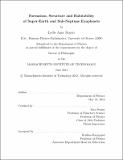Formation, structure and habitability of super-Earth and sub-Neptune exoplanets
Author(s)
Rogers, Leslie Anne
DownloadFull printable version (4.517Mb)
Alternative title
Structure, formation and habitability of super-Earth and sub-Neptune exoplanets
Other Contributors
Massachusetts Institute of Technology. Dept. of Physics.
Advisor
Sara Seager.
Terms of use
Metadata
Show full item recordAbstract
Insights into a distant exoplanet's interior are possible given a synergy between models and observations. Spectral observations of a star's radial velocity wobble induced by an orbiting planet's gravitational pull measure the planet mass. Photometric transit observations of a planet crossing the disk of its star measure the planet radius. This thesis interprets the measured masses and radii of super-Earth and sub-Neptune exoplanets, employing models to constrain the planets' bulk compositions, formation histories, and habitability. We develop a model for the internal structure of low-mass exoplanets consisting of up to four layers: an iron core, silicate mantle, ice layer, and gas layer. We quantify the span of plausible bulk compositions for low-mass transiting planets CoRoT-7b, GJ 436b, and HAT-P-11b, and describe how Bayesian analysis can be applied to rigorously account for observational, model, and inherent uncertainties. We present a detailed case study of GJ 1214b, the first exemplar of a new class of volatile-rich super-Earth exoplanets. At 6.5 Mo and 2.7 Ro, GJ 1214b must have a gas layer to account for its low mean density. We present three possible scenarios for the origin of the gas layer on GJ 1214b: direct accretion of H/He gas from the protoplanetary nebula, sublimation of ices, and outgassing of volatiles from a rocky interior. We next explore the low-density extreme of the mass-radius relations for volatilerich super-Earth exoplanets. Using models of planet formation, structure, and survival, we constrain the minimum plausible planet mass for a measured planet radius and equilibrium temperature. We explore both core-nucleated accretion and outgassing as two separate formation pathways for Neptune-size planets with voluminous atmospheres of light gases. Finally, we present a practical method to assess whether a hydrogen-rich sub-Neptune planet with measured mass and radius could potentially harbor a liquid water ocean. Using a one-dimensional radiative-convective model of energy transport through water-saturated hydrogen-rich envelopes, we constrain the combinations of planet properties (mass, radius, equilibrium temperature, intrinsic luminosity) that are conducive to liquid water oceans. The pace of low-mass exoplanet discoveries is poised to accelerate, and this thesis will contribute to constraining the interior properties of newfound planets.
Description
Thesis (Ph. D.)--Massachusetts Institute of Technology, Dept. of Physics, 2012. This electronic version was submitted by the student author. The certified thesis is available in the Institute Archives and Special Collections. Cataloged from student-submitted PDF version of thesis. Includes bibliographical references (p. 197-205).
Date issued
2012Department
Massachusetts Institute of Technology. Department of PhysicsPublisher
Massachusetts Institute of Technology
Keywords
Physics.